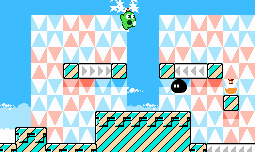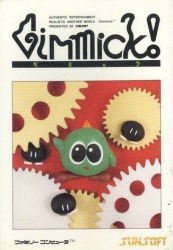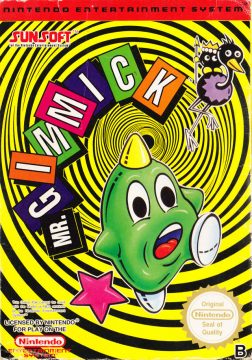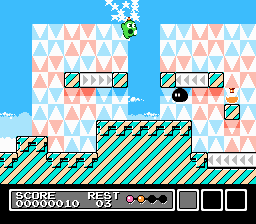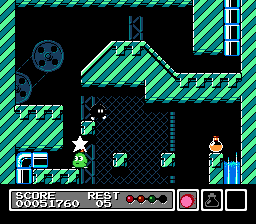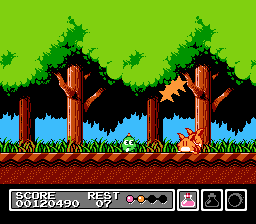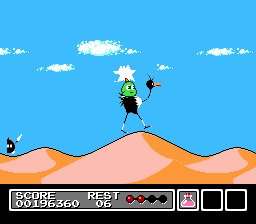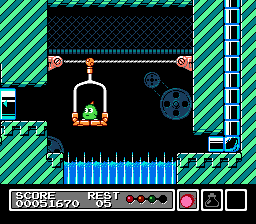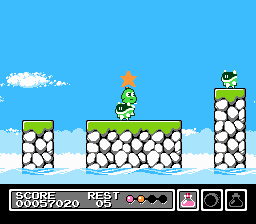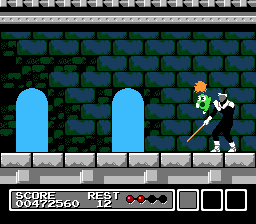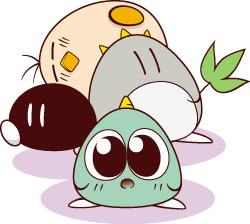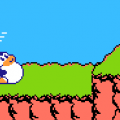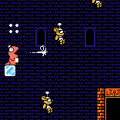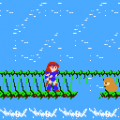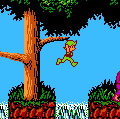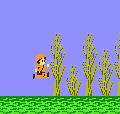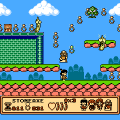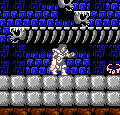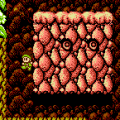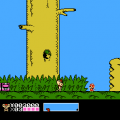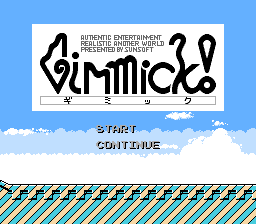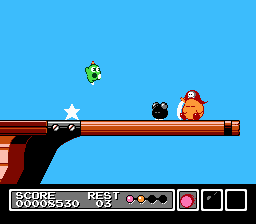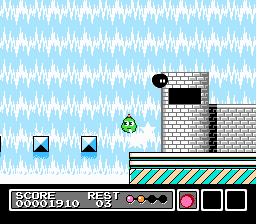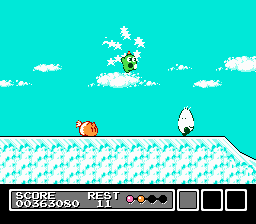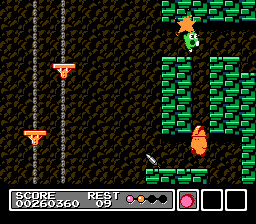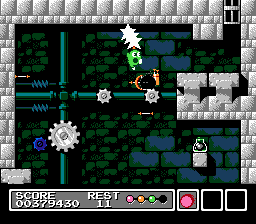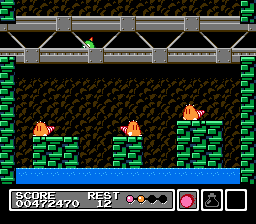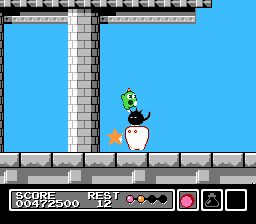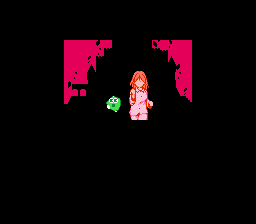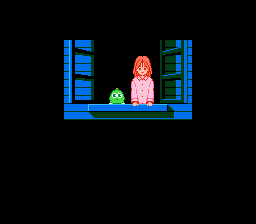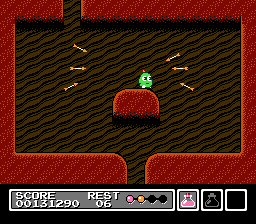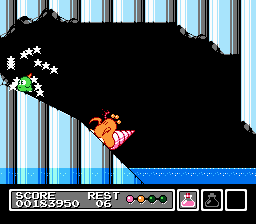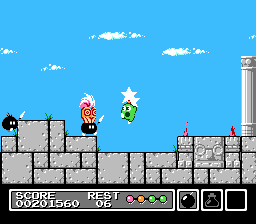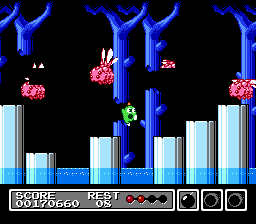Gimmick!, a late generation Famicom title from Sunsoft, is almost ridiculously adorable. In the short comic included in the game, and shown again in the introduction cinema, a father searches for a gift for his young daughter. He comes across the protagonist of this game, Yumetarou, who is a green boogery lump with gigantic eyes that take up roughly half its mass, and tiny little feet. He buys it, takes it home, and quickly becomes the darling of the girl’s toy chest. The other playthings grow jealous, and whisk her to another dimension, leaving Yumetarou to retrieve his (her? its?) master.
Gimmick! looks like an awful lot like a Kirby game, with its bright colors, loveable bad guys, and even more saccharine main character. However, the Kirby games are, for the most part, fluff. They are not designed so much as tossed together, with levels providing a playground for Kirby to use all kinds of neat powers. Kirby’s Adventure is Nintendo’s last great title on the platform (sorry Wario Woods fans) – but anyone looking for a substantial, challenging experience will end up feeling slightly entertained but ultimately disappointed. Gimmick!, on the other hand, is almost the precise opposite of Kirby’s Adventure – it’s not nearly as expansive, in both its levels or its abilities, but it is meticulously assembled, with each screen possessing unique challenges and situations that requires the player to be mentally invested at all times.
Gimmick! is an incredibly difficult game, and mastering it requires proper mastery of Yumetarou’s star attack. By holding down the button, you’ll charge this star over your head. When launched, it will bounce around the screen for a bit, taking down any enemies it runs into, until it flies off the screen or otherwise dissipates. Attacking with the star, at first, proves slightly troublesome. The angle which you throw it does not initially feel conducive, and simply hitting enemies can take awhile get used it. There are bottles found around the stages, of which up to three can be stored and selected for use at any time. Extra weapons include fireballs and bombs for more direct attacks, although other bottles can also extend your life meter beyond the standard three blocks to five.
The enemies are also remarkably aggressive and tend to attack in groups. The prolific black ball enemy things, with the cute eyes and tiny little legs, do not simply march forward and wait to be killed – they will follow you, they will jump over platforms to catch you, and do whatever it takes to match sure they kill you lest you kill them first. You can only toss a single star at once, so being able to take down multiple foes proves imperative. At least most enemies have a safe spot on their head, which allows you to ride them free of damage while you charge up the next attack. You can also ride the star, which is indeed necessary at many points, because it’s the only way to conquer several platforming challenges. Getting acclimated to this is even more difficult – it bounces too quickly to chase after, so you need to be able to properly reflect it off walls and time your jumps perfectly enough to catch it.
All of this gets more complicated when you take into account Gimmick!‘s physics engine, where slopes can affect the velocity of all objects, including Yumetarou, the enemies, and the stars. By the later boss battles, you need to be a master of this to properly calculate the trajectory of the bouncing star and make it fly into the sky, which is a mind boggling challenge when you’re already busy dodging numerous enemy projectiles.
Beating all six of the game’s stages with the three extra lives and three continues you’re granted is challenging enough – if you manage that feat, though, you’ll get a crappy ending. To become a true champion, you’ll need to find the hidden object in each stage, which usually requires even more ridiculous star bouncing manipulations – and a few semi-clever puzzles to solve – in order to reach. Additionally, you need to be able to do all of this without continuing. The game is already pretty hard – this is asking a bit much. To be fair, the hidden items are worth a ton of points and will usually give you a few extra lives, but this is sort of challenge that’s tailored specifically towards power gamers, easily holding its place next to Battletoads and Ninja Gaiden as one of the toughest games on the platform.
Even though it can grow maddening, Gimmick!‘s frustrations do not stem so much from design flaws so much as a demand for both meticulousness and fortitude, so even its worst moments it’s extremely hard to demonize it. It also doesn’t hurt that the levels are detailed in a way that makes practically every other 8-bit platformer look like amateur hour. It’s filled with unique enemies that only make single appearances or animations that exists solely because they can.
In the second stage, there are spiked-shelled tortoises similar to Super Mario Bros. If you flip it on its back, it’ll struggle helplessly – hop on top of it and its legs will actually carry you like a conveyor belt. It has absolutely no functional purposes, but it’s one of those things that the programmer must’ve thought was kinda cute. Additionally, if you’re fast enough, you can catch the boss of the stage snoozing, allowing you to push him off the edge of the screen and easily winning the stage.
At the beginning of the third level, little fox creatures will fall out of the trees, hop along with your character and then escape. They can hurt you, but they never actively attack you either – they are not necessarily enemies, but rather denizens of Gimmick!‘s world. Throughout the game, you’ll find the little black bean guys occasionally wearing various types of hats, presumably to indicate one being the leader. Some of the secret objects appear unguarded, but will spring a trap upon grabbing them. At the beginning of the fourth stage, you’ll find a creature who attempts to attack you but runs away. Later on the stage, you’ll find him setting a trap for you, although like the second stage boss, you can surprise him if you’re quick enough. This guy won’t even put up a fight – if attacked, he’ll just run away and dive into the nearby pool. If you manage to reach it, the final stage is oddly serene. It is full of creatures that look like enemies, but they do not attack you. Some of them are even simply napping, although this peaceful prelude grows fearsome by the time you reach the final boss.
It also looks and sounds brilliant. Sunsoft really stepped up their technical game in the later years of the Famicom, with some custom chips similar to Konami’s that greatly bolstered their graphical and aural qualities. Gimmick!doesn’t have the gigantic sprites or the fancy effects that were used in Batman: Return of the Joker, but it does have a unique visual style that puts in the league of Nintendo’s titles without directly copying them. The music, per most later gen Sunsoft releases, is also magnificent. The FME7/SUNSOFT5 memory mapper chip allows for three extra sound channels in addition to the standard five, bolstering their already strong sound library and creating an absolutely incredibly sounding music track filled with peppy, upbeat tunes to match its strange wonderland atmosphere.
The best video games have that sort of mystical power that somehow convinces us that there’s a living world inside of our games, rather than cold, unfeeling CPU calls and hex addresses. This is exemplified in Gimmick!, and it’s the same reason why titles like the PC Engine Dracula X are so highly regarded. The late release of the title in 1992 means that it’s quite rare and sought after in Japan. A US release was planned, and even reviewed (see below) was never officially released, facing the same fate as Ufouria (Hebereke in Japan), another Sunsoft title at the time.
It was, strangely enough, released in very small quantities to Scandinavian countries, where the name was changed to Mr. Gimmick. Like Uforia (Hebereke), it seemed like it was planned to get an international release, and even received a review in Electronic Gaming Monthly, but plans must have fallen through. Realizing the extreme difficulty but perhaps unable to do much to properly fix it, you’re granted nine lives instead of four, which certainly makes the player better equipped to deal with the challenges dealt. Given that European NES systems lack the proper hardware to utilize special sound chips inside of cartridges, the music has been slightly downgraded to fit the specs of a standard NES cart. However, the difference is not extreme – it’s now on the same level as Sunsoft’s other games like Journey to Silius and Gremlins 2, thereby only making it one of the best sounding titles on the NES, rather than the best. The PAL cart will not work properly on NTSC consoles, producing lots of graphical glitches. A prototype of the North American version has been leaked, and is identical to the PAL version, though without the bugs.
In the late 90s, Sunsoft began compiling some of their Famicom titles and releasing them on the PlayStation, two per CD, as part of the Sunsoft Memorial Collection. Gimmick! appears on the final release, Volume 6, along with Battle Formula (known as Super Spy Hunter in North America.) Like most of these ports, despite the improved hardware they end up coming out a bit funny. Although it looks and plays just fine, the music hasn’t quite made the transition as it should have. Ihe individual instruments sound slightly cleaner and quite a bit bassier, while the drum samples are almost entirely different. Some songs have extra melodies in them as well – whether these songs were slightly rearranged or certain parts made more evident as a result of translation is hard to tell. Still, while it’s hardly accurate, it still at least sounds pretty decent – it’s a huge step above previous titles in the Sunsoft Memorial series ([rʌf] World, contained on the fifth volume and also known as Journey to Silius, sounded remarkably terrible). Additionally, it can also be found in the Japanese marketplace for a mere 600 yen, which is substantially more reasonable than the price the Famicom version goes for in second hand shops.
Links:
YouTube – Annotated Longplay of Gimmick! One of the best “let’s play” style videos, it details all of the amazing little touches, and also pulls off some amazing feats (cheat assisted, mostly).
Electronic Gaming Monthly review
Mr. Gimmick was reviewed in the July 1992 issue of Electronic Gaming Monthly, where it got the ratings 5, 8, 5, 4. Check out image or read the transcribed text:
Intro: Mr. Gimmick is Sunsoft’s latest NES title. You play the part of Mr. Gimmick, a green blob with special magical gifts. His main weapon is a mystical star that forms over his head to seek out enemies. Collect bottles that give Mr. Gimmick new powers like fireballs, invincibility, and powerful bombs. The five levels are beautifully detailed with pastel colors while the bosses will present quite a challenge to Mr. Gimmick.
Steve: Here’s a game with a cool theme that could have been explored in a hundred different ways. Instead it’s a repetitive attempt at the action genre with difficult that is obviously geared to the wee sprites. Kids games don’t have to be completely lacking, however, and more time could made this one a winner. 5
Ed: OK, so it looks cutesy and seems like a great game for a 7 year old, but wait. Instead, you get a very challenging game that requires a great deal of technique. It starts off easy, but that is only practice. Get farther into the game and you’ll have quite a challenge. Definitely a sleeper. Give this one a try! 8
Martin: Mr. Gimmick has a few cool options to the game play and the cute theme will attract younger players. I can’t get excited about moving a little booger around the screen though. The graphics are OK and the sounds are decent but other that that [sic] the game play is very simple and needs more variety. Not bad, but not great. 5
Sushi-X: Mr. Gimmick is one of those games that the kiddies can relate to. The levels are nicely detailed for a NES game but with only five levels the variety just isn’t there. The music is kind of catchy but wears this after a while. The game plays rather well however. The score would have been higher if it wasn’t so easy. 4
—
Based on the comments regarding the difficulty, three out of the four reviewers clearly didn’t play the game for any length of time, if at all, only to dismiss it as “kid” stuff because it looks bright and cutesy. There are also six levels (seven if you count the hidden final stage, which requires incredible skill to get to) so they seemed to have based their review off an incorrect fact sheet of some kind. This attitude was sadly rather common in the magazine, which at the time was very dismissive to 8-bit games in favor of flashier 16-bit titles. (The forgettable Super Bowling for the SNES in the same issue got a 7, 8, 8 and 7, for context.)
